Q&A – Ask Neil: July 21, 2022
(Please read these instructions carefully.)
I hope you’re enjoying this new Q&A format. We’re still making minor adjustments, but it’s getting better.
• Click here to post your question.
• After you submit your question, a new window will pop up giving you the address to which you can e-mail a photo to accompany your question. Clear, medium-resolution photos (not thumbnails, please).
• Please only post your question one time.
• One question per reader, please.
• Please use this only for posting questions – not for standard emails.
• Watch for your answer in the following week’s e-gardens.
• I choose those of greatest general interest. For example, plant IDs seldom make the cut.
• I must have your first name or initials.
• I must have your city or county. (Texas is a very large state.)
QUESTION 1
SHOWY YELLOW SHRUBS ON SAM RAYBURN TOLLWAY
Question: What are the yellow shrubs being used so much on Sam Rayburn Tollway? They’re beautiful. M.M.G., McKinney.
Answer: Those are Sunshine ligustrums. I’ve been watching them since they were planted 4 or 5 years ago and I agree they are very stunning. However, I’ve pointed out a bed on the north side of Rayburn to my wife. It’s as you head west, where about 25 percent of the plants have reverted to green and are of widely varying sizes. If you head around the high-rise overpass and take the Tollway south you’ll see some beds where they’ve had to replant, I believe after the cold of 2021. The plants are very dramatic, but I would recommend using them in limited quantities. Note, also, that their mature height is described by Southern Living Plants as being 3 to 6 feet tall. That might be taller than many people would expect. Here is their website.
QUESTION 2
HOW TO HANDLE WEBWORMS
Question: My pecan trees are once again infested with bagworms (editor’s insertion: they’re actually fall webworms). The trees are too tall to spray and the pecan crop is not a concern. Is there a soil drench that will control these unsightly pests? J.P., Sadler.
Answer: You would be talking about a systemic insecticide, and that would have to be applied a month or two ahead of an infestation to give it time to be taken in through the roots and transported up through the trunk and limbs to the leaves. One thing to consider: You may not care much about the edibility of the pecans for you and your family, but you do need to be concerned about the animals that feed on them. Don’t apply any product unless it is legally labeled for use on pecans.
I live in a pecan forest, and I don’t anguish too much about fall webworms. I use a long-handled pole pruner to remove any webs that I can reach (generally 20 feet and lower). I figure that any that are higher than that – people shouldn’t be looking up that far anyway. 🙂 All you really have to do is break the webs open so the birds can harvest the caterpillars. To reinforce: these are fall webworms. Bagworms are the pests that attack redcedars and other conifers.
QUESTION 3
WHY NATIVE PLANTS SURVIVE DROUGHTS
Question: I am interested in the science of why native plants do so well during droughts. We have gone many weeks without measurable rain (late May), yet Pride of Barbados, Texas sage, Mexican heather, firecracker, etc. do well in these miserable situations. Steven S., New Braunfels.
Answer: I’m a God-fearing gardener! But I allow myself to believe in evolution, and plants that have shown an ability to survive extended periods of hot, dry weather are the ones that have survived to play another inning. Plants that were faint of heart fell by the wayside. But I always hasten to tell people that “native“ only means that it is growing where are you found it in nature. It may not be “adapted” 10 miles away if the soils and other environmental conditions are considerably different. That’s why I do not develop my landscapes solely around native plants. I prefer to use adapted plants, native or otherwise.
QUESTION 4
TOO LATE TO ADD MULCH?
Question: We added expanded shale to our flowerbeds but neglected to put down mulch. The soil is like cement. Water can’t penetrate it. Is it too late to add mulch? Several plants are dead because of the heat. Carol B., Keller.
Answer: When I am working up soil prior to planting, I still feel it is very important to work in organic matter. I use several sources of organic matter including sphagnum peat moss, finely ground pine bark mulch, well-rotted manure and compost. Then I include 1 inch of expanded shale with all of that organic matter, rototilling to 8 to 12 inches. Adding mulch on top of the soil without any organic matter in the soil will not be sufficient. One additional thought: Those plants that died probably died due to getting too dry and not solely because of the heat. Loosening the soil so the water can penetrate will be a big help.
QUESTION 5
WHAT TO DO WITH BROWNED MONDOGRASS?
Question: Our beds of monkeygrass (mondograss) were significantly burned while we were on an extended trip. What should we do now? Mow it? Trim out the affected plants? Will it put on a new flush of growth? Will it look terrible until next March? Jenni G., Dallas.
Answer: I may be living your nightmare. A neighbor had 18-wheeler truckloads of fill soil brought to his rural property. The huge trucks ran through my 225-foot-long mondograss bed and broke the sprinkler heads. There were so many broken heads that none of the other heads functioned at all. The leaks were below ground. I didn’t realize that there was a problem because I water in the middle of the night. That is, I didn’t realize until the weather turned hot and dry. I noticed about a week ago that the sunny end of that bed had turned quite brown. We have repaired the heads and broken pipes, and all I intend to do between now and the end of the year is keep the bed very well watered. I may fertilize it in September. If it looks much worse, I might consider trimming it. However, that’s a difficult job. Its leaves are very leathery, and they don’t cut easily. Good luck with your plants!
QUESTION 6
GETTING RID OF CREEPING CHARLIE
Question: I can’t find a way to get rid of creeping Charlie in my bermuda lawn. I’ve had limited success with 2,4-D. Any ideas? Mark A., Robinson.
Answer: 2,4-D is definitely the product to use. It is most effective when applied during active growth, and it is most effective when applied in a fine droplet spray. I would suggest using a tank sprayer (pump sprayer) that you dedicate for weed killers (since it’s hard to wash out the residues). That will allow you to vary the pressure as you pump, also the droplet size as you adjust the nozzle. Your goal is to coat the leaves of all broadleafed weeds. It will take a couple of weeks for it to take effect. It probably will not be as effective in these temperatures as it would have been earlier in the summer or even in late spring. For those with St. Augustine, be very cautious in using 2,4-D now. It can do serious damage to St. Augustine when applied at temperatures above 80-85F.
QUESTION 7
WHAT TO DO WITH TREE WOUND
Question: The city cut a huge limb from an elm tree outside our fence beside the road. There is an open place about 18 inches by 12 inches at the site where a branch was removed. I fear insects will damage the tree. Does the ragged opening need to be painted? Selah H., Arlington.
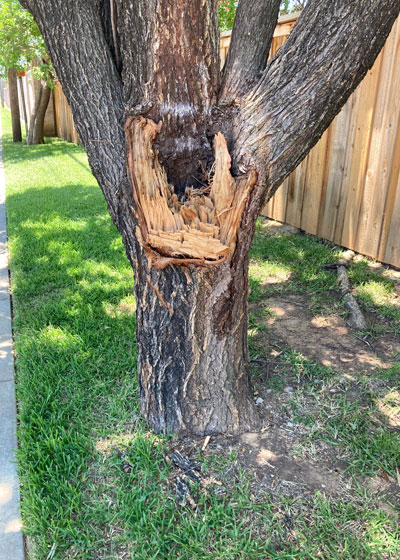
Answer: It looks like this branch may have fallen on its own. It would appear there was decay within the trunk of the tree already as evidenced by the darkened wood. I am very suspicious that the rest of the truck is weakened already, so I would consider having a certified arborist out immediately to inspect it. Don’t be surprised if the word is that you should have it taken down entirely before it hurts someone or comes down and injures a pet or person or does damage to an automobile. Painting isn’t going to help at all.
QUESTION 8
ARE CORA PERIWINKLES STILL BEING HIT BY DISEASE?
Question: Every year a few of our Cora periwinkles fade away like they did in the 90s due to fungus. Most thrive but some weaken and die. Is that fungus still around taking out periwinkles? Liz R., Hurst
This is a very serious water mold fungus known as Phytophthora. It pretty much took periwinkles away from us for 20 or 25 years. When the Cora series came into the market they were touted as being resistant to the disease, but gradually it moved in on them as well. Then Cora XDR periwinkles were introduced as “new and improved.” Those initials stand for Extra Disease Resistant, and they do appear to be honest improvements. Still, you want to plant periwinkles in raised beds once it has turned hot and dry in late May or June. There is nothing to be gained by rushing the planting season. And plant them in fresh soil or a new site every year. The fungus does accumulate in the soil.
QUESTION 9
IS AUCUBA GETTING TOO MUCH SUN?
Question: I planted a Sunny Daze Aucuba on the north side of the house in March. Recently some of the leaves are turning black. Are they getting scorched from the sun? Should I transplant the shrub to a shadier spot? If so, when? Lynn C., Tomball.
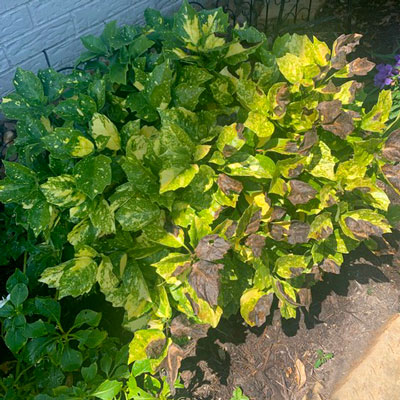
You have already diagnosed your own problem. If you look closely at your photograph you will see how much better the plant looks back against the house in the shade. It’s only where it sticks out into the sun that it has a problem. Yes, it needs to be moved into a total shade situation. The time to do so would be during the winter while it is dormant.
QUESTION 10
IS THIS TAKE ALL PATCH OR CHINCH BUGS?
Question: My lawn guy says I need to be watering every day in this heat, but I can’t afford this. I have treated for take all patch and chinch bugs. What caused this, and how can I stop it? I’m losing my St. Augustine. Jay G., Bedford.
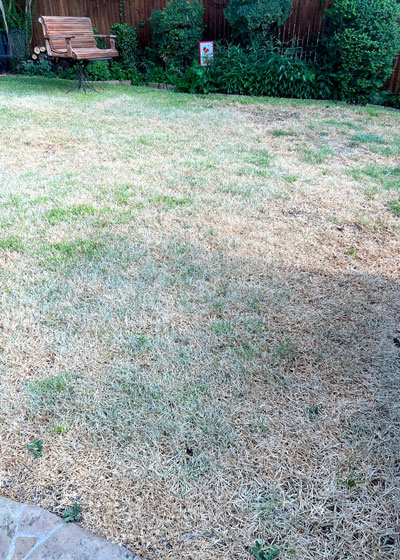
Answer: Oh, goodness! Looking at your photograph I’m going to guess that your lawn is being annihilated by chinch bugs. They will make the lawn look dry, but watering won’t solve the problem. The next day it will still be dry even though you watered it the night before. You can see the chinch bugs if you get down on your hands and knees and part the grass with your fingers. They are about the size of a B-B. They are black with irregular white diamonds on their backs. You will see them at the interface of healthy grass and dying grass. You may still be able to see them in your lawn, but again I remind you that they will not show up in the dead area. They will already have moved on.
QUESTION 11
WHAT IS WRONG WITH THIS MAGNOLIA?
Question: What is ailing my magnolia tree? Will it survive or should we plan on cutting it down? Deb B., Pilot Point.
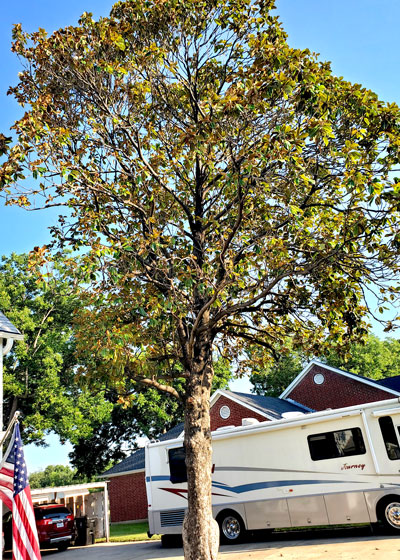
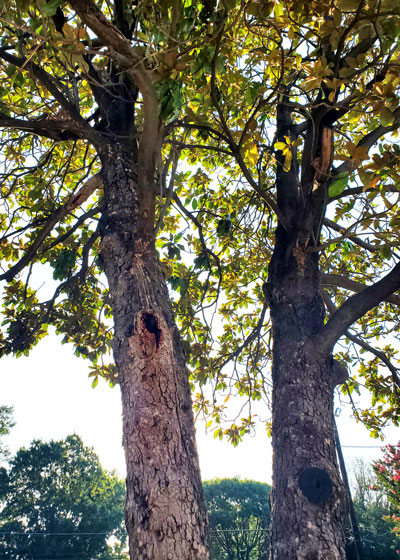
Answer: Have a certified arborist or a really good nursery professional look at your tree on site. It looks like there is active decay up and down the trunk. If that is the case, it may be difficult to save. But they will have the best idea once they can see the real problem. I don’t believe this is the result of any insect or disease damage. I think it’s more likely that a few branches were not pruned back flush with the trunk or that the jagged edges were left in place after the branches broke. They simply did not heal properly.
QUESTION 12
GOOD AND SHORT GROUNDCOVER FOR SUNNY SITE
Question: I have monkeygrass around the foundation of my house. It needs to be removed and replaced with a shorter groundcover. What do you suggest? The area receives west sun. Carol B., Forney.
Answer: If you’re talking about regular monkeygrass (mondograss), it only grows to 6 to 8 inches tall. I just want to establish that that is the height you consider too tall, because there aren’t many groundcovers that stay shorter than that. I guess you could use purple wintercreeper euonymus and keep it trimmed really short or maybe Asian jasmine with the same restriction, but both of those normally would grow to be the same 6 or 7 inches tall. They will handle the sun better than the mondograss would. (There probably will be somebody who will suggest dwarf mondograss, but it is not a good groundcover for a large bed due to its slow growth and propensity for diseases. It also wouldn’t tolerate all that sun.)
QUESTION 13
ARE OAK LEAVES OK AS A MULCH?
Question: Do you advise using mulched oak leaves in planting beds as a mulch? I’ve been doing so but have recently read that they’re not a good idea. Becca L., Tarrant Co.
That recommendation is probably coming from people who are concerned about tannic acid being a problem regarding the growth of your other “good“ plants. Pecans get the same negative comments for the oil in their leaves. However, I live in a pecan/oak forest and I have used their leaves run through a compost mulching set up for 45 years and have never felt that they caused any kind of a problem at all. Remember that you’re talking about putting these on top of the soil. That further minimizes any impact they would have because you’re not mixing them into the soil where they will make contact with plants’ roots. I’m going “whole hog,” mixing them into my soil. You’re just talking about using them on top of the soil. Go for it!
QUESTION 14
WHAT IS WHITE COATING ON LIVE OAK TREE?
Question: Can you please tell me what the white coating is on my very large live oak tree and if I should be doing something about it? Cindy P., Dallas.
Answer: Oh, what I would give for a photograph about now. I don’t know if you were seeing lichens on the trunk of your tree. They are harmless symbiotic growths of algae and fungi that are merely using the trunks of oaks as their supports. They also will develop on the surfaces of boulders, so they’re obviously not deriving any nutrition from the trees. You might also be seeing mineral salts from a sprinkler system. You’ll see the same thing happening to wood fences where sprays hit the fences repetitively in the same patterns time after time. If you were in South Texas I would have suggested you Google “bark lice” to see if that might have been a consideration. As you can obviously tell, I have no clue of your precise answer, but I’ve given you several things to consider. Please include a photo next time.
